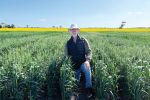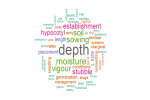Author: Nicole Baxter
184 results found:-

Variety trials empowered as a national program
Author: Nicole Baxter, 2025-01-17T09:00:00+11:00Former National Variety Trials (NVT) manager Alan Bedggood is proud to have helped set up a system to support growers in choosing new varieties for their farms.
-

Precision tillage puts lime where needed
Author: Nicole Baxter, 2025-01-16T09:00:00+11:00Accurate deep tillage, lime incorporation and trace elements have added resilience to a NSW family farming business
-

Partnership puts a measure on GHG emissions
Author: Nicole Baxter, 2025-01-15T09:00:00+11:00A whole-of-supply-chain partnership is giving growers the know-how to reduce on-farm greenhouse gas emissions and improve soil productivity
-

NVT – independent and data rich
Author: Nicole Baxter, 2025-01-14T09:00:00+11:00Prominent plant breeder and former GRDC managing director Dr Steve Jefferies reflects on the value of the NVT to breeding companies and growers.
-

Experienced insider motivated by data sharing
Author: Nicole Baxter, 2025-01-07T09:00:00+11:00A background in farming and an agricultural science degree have equipped Neale Sutton for a long-term career with GRDC’s National Variety Trials
-

Faba bean data reduces canola area
Author: Nicole Baxter, 2024-12-11T09:00:00+11:00Long-term farming systems trial results and the outcomes of a benchmarking study have given Paul Tognetti the confidence to try faba beans
-

Time to stop giving weeds a free ride
Author: Nicole Baxter, 2024-10-15T09:00:00+11:00Growers moving fodder and harvest machinery are encouraged to take extra care to avoid spreading invasive weeds such as annual ryegrass and parthenium. University of Queensland Professor Bhagirath Chauhan says the movement of annual ryegrass-infested fodder and machinery has caused the weed to spread north. The greatest weed threat to New South Wales is considered to be parthenium. Since April 2020, 49 parthenium infestations have been detected and are being eradicated following movements of contaminated hay, grain, vehicles and machinery from Queensland.
-

Wet springs require proactive Sclerotinia management
Author: Nicole Baxter, 2024-10-10T09:00:00+11:00In wet spring conditions, western Victorian growers cannot be complacent about managing Sclerotinia in canola
-

Assess Sclerotinia risk to assist crop planning
Author: Nicole Baxter, 2024-10-09T09:00:00+11:00Plant pathologists have found that some pulse species are more susceptible than others to the damaging diseases Sclerotinia white mould and Sclerotinia stem rot. The three species of the pathogen found in pulse crops are Sclerotinia sclerotiorum, S. minor and S. trifoliorum. Sclerotinia’s hosts include canola, chickpeas, lentils, faba beans, lupins, vetch, field peas and pasture and broadleaf weeds. Wheat, barley and oats are not hosts. NSW Department of Primary Industries and Regional Development senior plant pathologist Dr Kurt Lindbeck says narrow-leafed lupins and chickpeas are highly susceptible to the disease.
-

Winter canola proves profitable at Weatherboard
Author: Nicole Baxter, 2024-10-07T09:00:00+11:00Ben Findlay’s farm near Weatherboard, Victoria, utilises ungrazed winter canola, specifically the hybrid RGT Nizza CL because its flowering window suits his climate. He finds the winter varieties are about half a tonne per hectare higher yielding than the spring varieties for his area. He sows the variety from late March to early April. After applying a double knock for weeds, he targets 30 plants per square metre (about 1.8 kilograms of seed/ha) and plants as shallow as possible, applying 100kg/ha of monoammonium phosphate with the seed.
























































